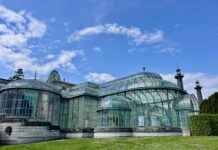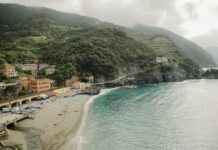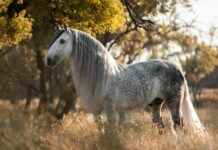In his field near Blesle, the ears of wheat with sometimes reddish hues are sparse, the stems are not very high, a reflection of the spring drought that the recent rains have not compensated for.
«What’s the use of lamenting? It’s the proof that I let nature take its course and that I don’t irrigate!» launches Pascal Lemaire, without departing from his optimism by showing his plot, where insects – spiders, butterflies, grasshoppers – are kings.
On his 36 hectares of land, he cultivates wheat, barley, oats, rye: only old cereals and «100% Auvergne», specifies the farmer with graying hair and skin already tanned by the June sun.
Rouge d’Alsace, Milanais de Limagne, Trésor du Velay, Megalia: these names, more evocative of grape varieties than cereals, designate varieties «cultivated before the war in our countryside». «Then when we put in chemicals, we said to ourselves that this wheat sucks when we could have said fertilizer sucks» regrets the fifty-year-old.
After the war, faced with the need to feed the population, genetic crosses made it possible to obtain modern wheat that was more resistant to disease and more productive. Bread could be made faster with faster rising dough.
-Less gluten-
But these varieties are also more demanding in fertilizers and chemicals. And richer in gluten, poorly tolerated by organisms.
«Today, we have 50 years of hindsight on this model, we can draw conclusions from it, there are alternative solutions», wants to believe Pascal Lemaire, born a few meters away, on the farm where his father raised suckler cows.
After joining INRAE (National Research Institute for Agriculture, Food and the Environment) in 1994, he spent more than twenty years there, a good part of which studying the different types of wheat.
When his father died in 2013, he decided to grow ancient wheat on the plots he inherited, with seeds made available to the public by INRAE.
To devote himself to his passion for the land, he laid off in 2017 until his resignation at the start of the year: «I was fed up with a system based on a unique agricultural model with maximum productivity».
Modern wheats are not suitable for organic farming, unlike ancient wheats, he says, rejecting a model that impoverishes the soil.
«I like to make my soil live with longer rotations (crop changes), legumes like alfalfa which retain nitrogen and green manures», he explains.
Its flour is sold to a baker as well as to about fifty individuals. A local brewer concerned about using products «that make sense» buys barley from him to make his beer.
«With fifty hectares instead of 36, I could have an income allowing me to live», assures the farmer.
The yield is lower than modern wheat, but the costs are «less important without fertilizer» and the wheat sold «up to three times more expensive»: around 450 euros per tonne against 200 for modern varieties.
Associated with about twenty farmers, he formed an economic and environmental interest group. «I encourage others to observe the wheat, that’s the key: take notes, compare, come and watch your crops,» he says.
«Passionate about the peasantry in the noble sense of the term», he sweeps away the critics who accuse him of operating «a counter-productive and backward-looking step back».
«My flour is there to awaken the senses, to recall the smells of childhood and the taste of real bread. I want people to eat well. Being a farmer means bringing your country to life. And that’s this is how the profession takes on its full meaning».
















